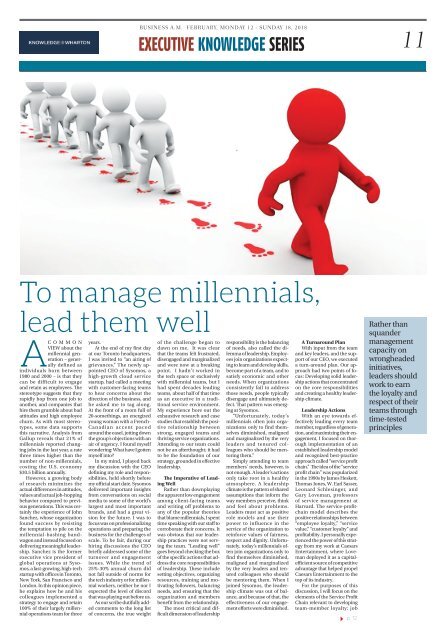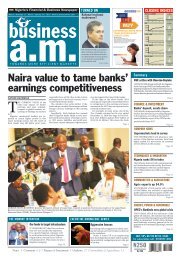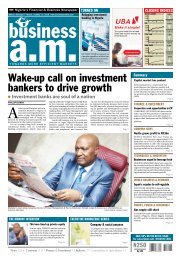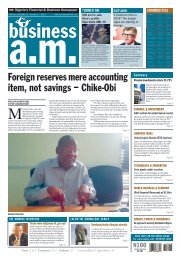12-02-2018
Create successful ePaper yourself
Turn your PDF publications into a flip-book with our unique Google optimized e-Paper software.
BUSINESS A.M. FEBRUARY, MONDAY <strong>12</strong> - SUNDAY 18, <strong>2018</strong><br />
EXECUTIVE KNOWLEDGE SERIES<br />
11<br />
To manage millennials,<br />
lead them well<br />
A<br />
COMMON<br />
VIEW about the<br />
millennial generation<br />
– generally<br />
defined as<br />
individuals born between<br />
1980 and 2000 – is that they<br />
can be difficult to engage<br />
and retain as employees. The<br />
stereotype suggests that they<br />
rapidly hop from one job to<br />
another, and companies that<br />
hire them grumble about bad<br />
attitudes and high employee<br />
churn. As with most stereotypes,<br />
some data supports<br />
this narrative. Analysis from<br />
Gallup reveals that 21% of<br />
millennials reported changing<br />
jobs in the last year, a rate<br />
three times higher than the<br />
number of non-millennials,<br />
costing the U.S. economy<br />
$30.5 billion annually.<br />
However, a growing body<br />
of research minimizes the<br />
actual differences in attitudes,<br />
values and actual job-hopping<br />
behavior compared to previous<br />
generations. This was certainly<br />
the experience of John<br />
Sanchez, whose organization<br />
found success by resisting<br />
the temptation to pile on the<br />
millennial-bashing bandwagon<br />
and instead focused on<br />
delivering meaningful leadership.<br />
Sanchez is the former<br />
executive vice president of<br />
global operations at Sysomos,<br />
a fast-growing, high-tech<br />
startup with offices in Toronto,<br />
New York, San Francisco and<br />
London. In this opinion piece,<br />
he explains how he and his<br />
colleagues implemented a<br />
strategy to engage and retain<br />
100% of their largely millennial<br />
operations team for three<br />
years.<br />
At the end of my first day<br />
at our Toronto headquarters,<br />
I was invited to “an airing of<br />
grievances.” The newly appointed<br />
CEO of Sysomos, a<br />
high-growth cloud service<br />
startup, had called a meeting<br />
with customer-facing teams<br />
to hear concerns about the<br />
direction of the business, and<br />
he asked me to tag along.<br />
At the front of a room full of<br />
20-somethings, an energized<br />
young woman with a French-<br />
Canadian accent paced<br />
around the easel, jotting down<br />
the group’s objections with an<br />
air of urgency. I found myself<br />
wondering: What have I gotten<br />
myself into?<br />
In my mind, I played back<br />
my discussion with the CEO<br />
defining my role and responsibilities,<br />
held shortly before<br />
my official start date. Sysomos<br />
delivered important insights<br />
from conversations on social<br />
media to some of the world’s<br />
largest and most important<br />
brands, and had a great vision<br />
for the future. I was to<br />
focus was on professionalizing<br />
operations and preparing the<br />
business for the challenges of<br />
scale. To be fair, during our<br />
hiring discussions the CEO<br />
briefly addressed some of the<br />
turnover and engagement<br />
issues. While the trend of<br />
25%-30% annual churn did<br />
not fall outside of norms for<br />
the tech industry or for millennial<br />
workers, neither he nor I<br />
expected the level of discord<br />
that was playing out before us.<br />
As our scribe dutifully added<br />
comments to the long list<br />
of concerns, the true weight<br />
of the challenge began to<br />
dawn on me. It was clear<br />
that the teams felt frustrated,<br />
disengaged and marginalized<br />
and were now at a breaking<br />
point. I hadn’t worked in<br />
the tech space or exclusively<br />
with millennial teams, but I<br />
had spent decades leading<br />
teams, about half of that time<br />
as an executive in a traditional<br />
service environment.<br />
My experience bore out the<br />
exhaustive research and case<br />
studies that establish the positive<br />
relationship between<br />
strong, engaged teams and<br />
thriving service organizations.<br />
Attending to our team could<br />
not be an afterthought; it had<br />
to be the foundation of our<br />
strategy, grounded in effective<br />
leadership.<br />
The Imperative of Leading<br />
Well<br />
Rather than downplaying<br />
the apparent low engagement<br />
among client-facing teams<br />
and writing off problems to<br />
any of the popular theories<br />
that blame millennials, I spent<br />
time speaking with our staff to<br />
corroborate their concerns. It<br />
was obvious that our leadership<br />
practices were not serving<br />
the team. “Leading well”<br />
goes beyond checking the box<br />
of the specific actions that address<br />
the core responsibilities<br />
of leadership. These include<br />
setting objectives, organizing<br />
resources, training and motivating<br />
followers, balancing<br />
needs, and ensuring that the<br />
organization and members<br />
benefit from the relationship.<br />
The most critical and difficult<br />
dimension of leadership<br />
responsibility is the balancing<br />
of needs, also called the dilemma<br />
of leadership. Employees<br />
join organizations expecting<br />
to learn and develop skills,<br />
become part of a team, and to<br />
satisfy economic and other<br />
needs. When organizations<br />
consistently fail to address<br />
those needs, people typically<br />
disengage and ultimately defect.<br />
That pattern was emerging<br />
at Sysomos.<br />
“Unfortunately, today’s<br />
millennials often join organizations<br />
only to find themselves<br />
diminished, maligned<br />
and marginalized by the very<br />
leaders and tenured colleagues<br />
who should be mentoring<br />
them.”<br />
Simply attending to team<br />
members’ needs, however, is<br />
not enough. A leader’s actions<br />
only take root in a healthy<br />
atmosphere. A leadership<br />
climate is the pattern of shared<br />
assumptions that inform the<br />
way members perceive, think<br />
and feel about problems.<br />
Leaders must act as positive<br />
role models and use their<br />
power to influence in the<br />
service of the organization to<br />
reinforce values of fairness,<br />
respect and dignity. Unfortunately,<br />
today’s millennials often<br />
join organizations only to<br />
find themselves diminished,<br />
maligned and marginalized<br />
by the very leaders and tenured<br />
colleagues who should<br />
be mentoring them. When I<br />
joined Sysomos, the leadership<br />
climate was out of balance,<br />
and because of that, the<br />
effectiveness of our engagement<br />
efforts were diminished.<br />
A Turnaround Plan<br />
With input from the team<br />
and key leaders, and the support<br />
of our CEO, we executed<br />
a turn-around plan. Our approach<br />
had two points of focus:<br />
Developing solid leadership<br />
actions that concentrated<br />
on the core responsibilities<br />
and creating a healthy leadership<br />
climate.<br />
Leadership Actions<br />
With an eye towards effectively<br />
leading every team<br />
member, regardless of generation,<br />
and maximizing their engagement,<br />
I focused on thorough<br />
implementation of an<br />
established leadership model<br />
and recognized best-practice<br />
approach called “service profit<br />
chain.” The idea of the “service<br />
profit chain” was popularized<br />
in the 1990s by James Heskett,<br />
Thomas Jones, W. Earl Sasser,<br />
Leonard Schlesinger, and<br />
Gary Loveman, professors<br />
of service management at<br />
Harvard. The service-profitchain<br />
model describes the<br />
positive relationships between<br />
“employee loyalty,” “service<br />
value,” “customer loyalty” and<br />
profitability. I personally experienced<br />
the power of this strategy<br />
from my work at Caesars<br />
Entertainment, where Loveman<br />
deployed it as a capitalefficient<br />
source of competitive<br />
advantage that helped propel<br />
Caesars Entertainment to the<br />
top of its industry.<br />
For the purposes of this<br />
discussion, I will focus on the<br />
elements of the Service Profit<br />
Chain relevant to developing<br />
team-member loyalty: job<br />
p. <strong>12</strong><br />
Rather than<br />
squander<br />
management<br />
capacity on<br />
wrongheaded<br />
initiatives,<br />
leaders should<br />
work to earn<br />
the loyalty and<br />
respect of their<br />
teams through<br />
time-tested<br />
principles










